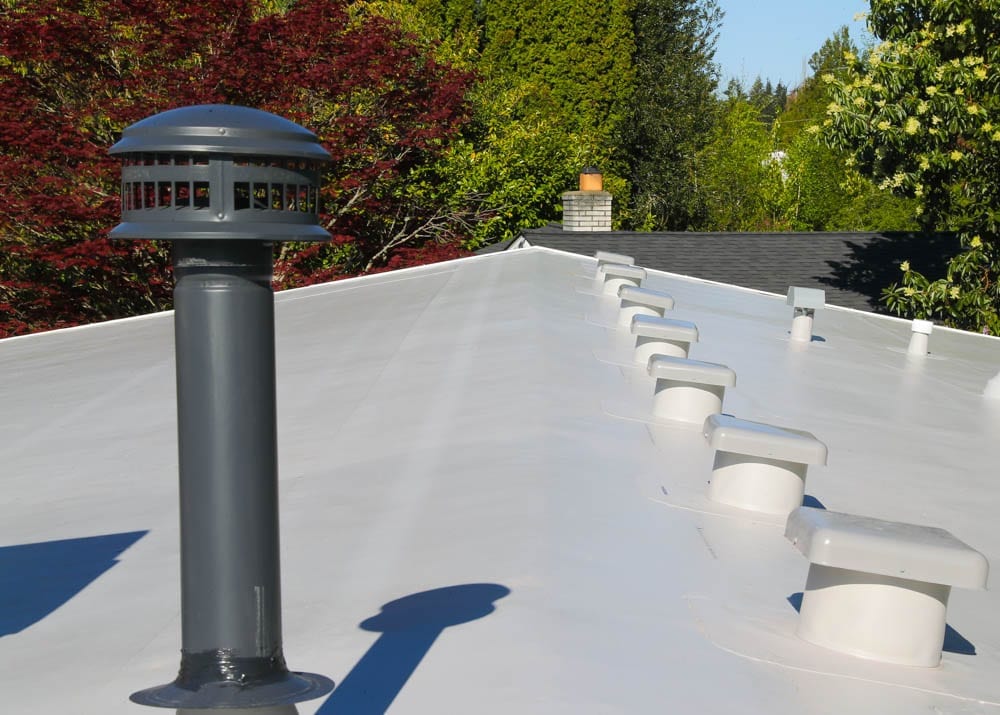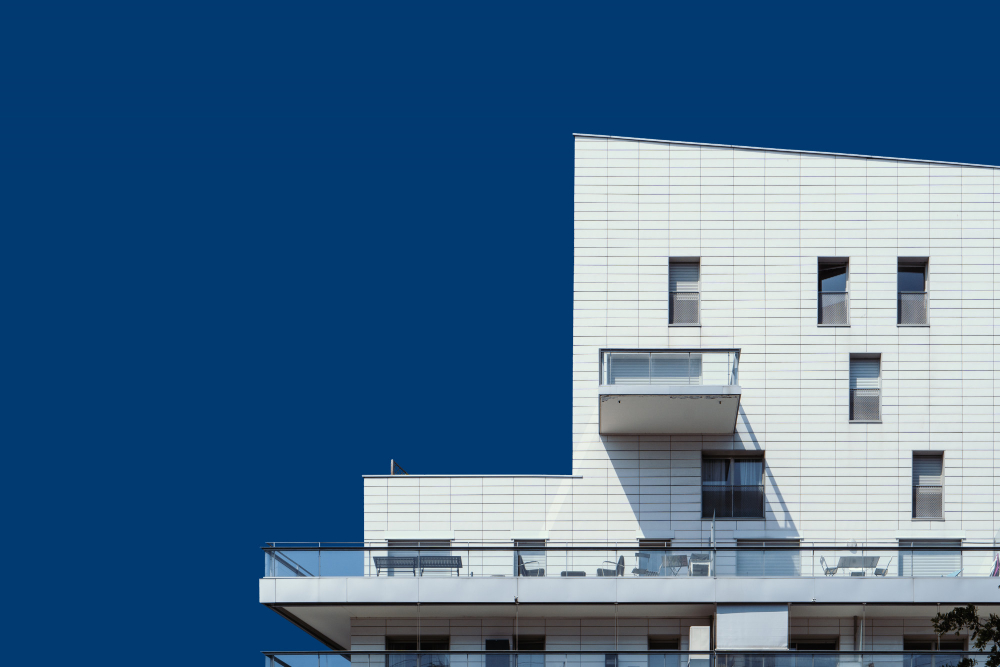Commercial Roofing

TPO Roofing
What is TPO Roofing Material?
Introduced in the early 1990s, Thermoplastic Polyolefin (TPO) stands out as a roofing material. This single-ply roofing membrane comprises three layers: a TPO polymer base, a polyester-reinforced scrim, and a TPO compounded top ply. The National Roofing Contractors Association’s report highlights TPO’s emergence as an alternative to rubber and PVC roofs. Notably, TPO has rapidly gained traction, accounting for an estimated 40% of the commercial roofing market. Recognized for its myriad advantages, TPO roofing is widely recommended for commercial business owners, making it one of the most favored products in the market.
TPO Roofs Benefits
Roofers prefer TPO roofs due to the straightforward installation process. The material’s wide sheets reduce the number of roof seams, ensuring a clean and less labor-intensive installation compared to other roofing materials.
TPO stands out as one of the most budget-friendly options in commercial roofing, surpassing the affordability of PVC or rubber roofs. The simplicity of installation translates to cost savings that can be passed on to the customer. Moreover, TPO roofs typically boast a lifespan of 15 to 20 years, requiring minimal maintenance.
TPO exhibits resistance to mold, dirt, and grime, along with being fire and chemical resistant. Its durability extends to puncture resistance, and its flexibility allows it to adapt to roof slopes, maintain integrity during natural roof movements, and endure typical thermal expansion.
Environmentally Conscious & Energy-Efficient TPO’s heat-reflective properties contribute to energy efficiency by resisting UV, ozone, and chemical exposure. Choosing TPO can lead to reduced cooling costs, and its eco-friendly nature—lacking chlorine and being 100% recyclable—contributes to lower carbon emissions.
Leak Detection Simplicity Thanks to heat-welded seams, identifying and repairing leaks in TPO roofs is a straightforward process. This quick and cost-effective repair method minimizes inconvenience and expenses for consumers.
Commercial Roofing

Bitumen Roofing
What is Modified Bitumen Roofing?
Crafted from a blend of asphalt and polymerized rubber or plastic, modified bitumen roofing is further strengthened with fiberglass, resulting in a durable yet flexible waterproof membrane. This roofing type finds its predominant application on flat or low-slope commercial roofs. Depending on the specific type and material, these membranes can be installed either within a two-layer system or as integral components of a multi-ply system.
In the mid-1960s, modified bitumen made its debut in commercial roofing in Europe. Before its introduction, the prevailing roofing system for most commercial structures was built-up roofing (BUR), a complex arrangement involving alternating layers of asphalt and fabric topped with gravel.
Despite its proven track record, BUR presented challenges such as weight, high installation costs, intricate repairs, and susceptibility to extreme temperatures. Seeking to streamline the roofing process and address these common issues, developers incorporated polymers and fiberglass into bitumen, creating a simplified membrane for modified bitumen.
The results were favorable. Modified bitumen offered easier installation and enhanced protection compared to BUR systems, even in harsh cold temperatures. By 1975, the adoption of modified bitumen had become widespread in the United States. Today, it has largely supplanted BUR as one of the most reliable roofing materials in the market.
Modified Bitumen Roofing Benefits
Modified bitumen stands out for its exceptional durability and tensile strength, providing resilience against tears caused by weathering, debris, and regular foot traffic.
When installed correctly, modified bitumen ranks among the most effective roofing materials in terms of waterproofing. Additional redundant layers contribute to further enhancing this water-resistant quality.
Modified bitumen proves to be user-friendly during installation and exhibits simplicity in maintenance. In the event of tears or leaks, it can be easily patched.
Modified bitumen displays flexibility, accommodating expansions and contractions in response to changing weather conditions without compromising its structural integrity.
Certain variations of modified bitumen offer excellent UV resistance and sun-reflective properties, contributing to lower energy bills through reduced heat absorption.
Application Techniques for Modified Bitumen
Usually supplied in membrane rolls, modified bitumen is applied directly to the substrate using an adhesive. The installation methods include heat welding, cold adherence, or, in certain instances, self-adherence—such as with numerous top products from Polyglass featuring ADESO® self-adhering technology.
Alternatively, some modified bitumen membranes may be mechanically attached. While many applications require a minimum of two layers (comprising a base layer and a cap layer), there are scenarios where it is incorporated into a multi-ply system consisting of three or more layers.
Commercial Roofing

PVC Roofing
What is a PVC roofing membrane?
Overview:
A PVC roofing membrane is a widely used thermoplastic single-ply roofing material prevalent in commercial and industrial applications, with limited use in residential roofing.
Composition:
PVC, short for polyvinyl chloride, is the base material. Unlike rigid PVC used in pipes or house trim, a PVC roofing membrane incorporates plasticizers during manufacturing to maintain flexibility. The final product consists of a polyester or fiberglass reinforcement fabric mat sandwiched between two layers of plasticized PVC.
Flexibility Over Time:
Over time, the plasticizers slowly migrate from the membrane, impacting flexibility. An aged PVC roof may exhibit reduced flexibility compared to a new installation. In contrast, TPO membranes do not rely on plasticizers, resulting in a different flexibility dynamic over the years.
Thickness Variations:
PVC roof membranes are available in different thicknesses, such as 50 mils, 60 mils, and 80 mils, with a mil representing 1/1000 of an inch. Thicker membranes contribute to extended longevity, although costs rise proportionately. The overall thickness of a commercial PVC roof includes cover board and insulation layers, complying with insulation R-value requirements.
Important things to know about a PVC roofing membrane
PVC membranes are ideal for low-slope roofs (below 3/12 pitch), providing a monolithic, waterproof surface compared to water-shedding shingle or tile systems.
Specialized contractors are essential for PVC roof installation or repairs due to the need for specific equipment and expertise. Installation involves layers like the roof deck, vapor barrier, insulation board, cover board, and the membrane itself.
- Mechanically Attached: Rows of fasteners hold the membrane in place through batten strips. This cost-effective method is suitable for large commercial roofs.
Adhesives secure layers, and the membrane itself is glued to the cover board. Common in residential roofing, fully adhered systems offer durability and aesthetic appeal. - Heat Welding: PVC, being a thermoplastic material, utilizes heat welding for seaming. Special tools heat edges to around 1,100°F, creating strong bonds between sheets. Heat welding is also employed for flashings, patching, and repairs.
Understanding these aspects helps in making informed decisions about when and how to use PVC roofing membranes, ensuring effective and long-lasting results.
Commercial Roofing

Roof Coating
What is a Roof Coating?
Roof coating application is a protective process designed to prolong the lifespan of installed roofing systems. Also referred to as a roof covering, these coatings utilize a dense formula containing high-quality resins. Each application adds an additional layer of protection, with the resins ensuring the coating’s elastic properties endure over its life cycle. Once cured, the roof coating forms a new monolithic layer, providing enhanced waterproofing properties that can bridge small cracks and membrane seams on roofs.
Types of Roof Coatings
Understanding the strengths and weaknesses of different roof coating types helps in selecting the most suitable one:
- Acrylic Roof Coatings: Ideal for diverse climates, acrylic coatings offer a balance of cost and performance. However, they may lose thickness over time and are recommended for drier climates.
- Elastomeric Roof Coatings: Resilient and cost-effective, elastomeric coatings withstand various weather conditions. They are suitable for positively pitched roofs or as a base coat when combined with other coatings.
- Silicone Roof Coatings: Moisture-cured and weather-resistant, silicone coatings are recommended for homes and buildings in wet locations. They resist erosion but may retain dirt and dust.
Benefits of Roof Coatings
Roof coatings contribute to environmental conservation by avoiding landfill waste, allowing the restoration of existing roofs by reusing materials. Additionally, certain coatings qualify for sustainability programs like the US Green Building Council’s LEED program.
Roof coating applications offer a sustainable approach with quick and easy installation compared to extensive re-roofing projects. This efficiency can lead to cost savings and minimal disruption to normal business operations.
Roof coatings prove more cost-effective than traditional roofing services due to reduced labor and material costs. The application directly overlays the existing roof, eliminating the need for extensive demolition.
Reflective roof coatings minimize UV absorption, reducing energy costs by creating a cooler indoor environment. This energy-efficient aspect aids in lowering air conditioner use.
Roof coatings are renewable, allowing for re-coating every 10+ years to extend roof life. Renewing reflectivity through maintenance ensures long-lasting waterproofing capabilities.
The quick and straightforward installation process, often completed in a day or two, makes roof coatings a convenient alternative to time-consuming tear-off and re-roof installations.
Choosing the Right Roof Coating: Factors such as roof materials, size, slope, location, and weather conditions play a crucial role in determining the best roof coating. Professional roof coating specialists can customize a formula based on these considerations, ensuring optimal protection and restoration for your specific roof.
Commercial Metal Roofs

Metal Roofing
What is a Commercial Metal Roof?
A metal roofing system designed for commercial use is constructed from durable metal materials, offering a resilient and enduring solution for commercial structures. Engineered to withstand a variety of weather conditions, environmental challenges, and the rigorous demands of commercial spaces, these roofs are commonly crafted from steel, aluminum, or copper. Commercial metal roofs provide a blend of strength, versatility, and aesthetic appeal.
Standing Seam Metal Roofs:
Design: Consists of vertical metal panels with raised seams.
Benefits: Excellent waterproofing, sleek appearance, and easy maintenance. Ideal for modern and energy-efficient commercial buildings.
Corrugated Metal Roofs:
Design: Features repeating corrugations or ridges for added strength.
Benefits: Lightweight, cost-effective, and suitable for various commercial applications. Provides a distinctive industrial appearance.
Metal Shingle Roofs:
Design: Mimics the look of traditional shingles but made from metal.
Benefits: Aesthetic versatility with the durability of metal. Suitable for commercial spaces where a more traditional appearance is desired.
Metal Tile Roofs:
Design: Resembles traditional clay or concrete tiles but made from metal.
Benefits: Mimics the appearance of traditional materials while offering the strength and durability of metal. Lightweight and energy-efficient.
Flat Seam Metal Roofs:
Design: Flat metal panels that are seamed together.
Benefits: Smooth appearance, ideal for modern and minimalist designs. Suitable for low-slope or flat commercial roofs.
Benefits of Commercial Metal Roofs
Commercial metal roofs are renowned for their robustness and long lifespan, capable of withstanding extreme weather conditions such as high winds, heavy snow loads, and hail.
Metal roofs necessitate minimal maintenance, reducing long-term costs associated with roof upkeep. Regular inspections and occasional cleaning are typically sufficient.
Reflective coatings and cool metal roofing options contribute to energy efficiency by minimizing heat absorption. This, in turn, can lead to lower cooling costs for commercial spaces.
Metal inherently offers fire resistance, providing an additional layer of safety for commercial buildings, particularly crucial in areas prone to wildfires or subject to strict fire codes.
Commercial metal roofs come in various styles, ranging from sleek and modern to traditional and classic. This versatility enables businesses to choose a roofing solution that complements the architectural style of their commercial space.
Metal roofing materials are recyclable, making them an eco-friendly choice. Additionally, the reflective nature of metal roofs contributes to lower energy consumption, aligning with sustainability goals.
Metal roofs are often quicker to install than traditional roofing materials, minimizing disruption to commercial activities during the installation process.
Unlike some other roofing materials, metal is resistant to mold and mildew growth, ensuring a healthier indoor environment for commercial spaces.
While the initial cost of a metal roof may be higher than some alternatives, its long lifespan and low maintenance requirements make it a cost-effective choice over the building’s life.
The durability, energy efficiency, and aesthetic appeal of a metal roof can enhance the overall value of a commercial property.
In summary, opting for a commercial metal roof represents a sturdy and dependable choice for businesses in search of a roofing solution that seamlessly integrates durability, energy efficiency, and versatile design. With a range of types available, commercial metal roofs stand as a prudent investment, offering long-term protection and enhancement for commercial structures.
Commercial Flat Roofs

Flat Roofing
What is a Commercial Flat Roof?
A commercial flat roof is a horizontally oriented roofing structure with a minimal slope, offering a versatile and space-efficient solution for commercial buildings. Unlike traditional steep-slope roofs, flat roofs are easily installed, accessible, and adaptable for various commercial applications, commonly found in urban areas.
Built-Up Roofing (BUR):
Construction: Alternating layers of bitumen and reinforcing fabrics (ply sheets).
Benefits: Durability, waterproofing, and UV resistance. Ideal for high-traffic buildings.
Modified Bitumen Roofing:
Construction: Asphalt-based rolls with added modifiers like rubber or plastic.
Benefits: Enhanced flexibility, durability, and easy installation. Suitable for extreme temperature flexibility.
Single-Ply Membrane Roofing:
Materials: PVC, TPO, or EPDM.
Benefits: Lightweight, energy-efficient, and UV-resistant. Quick and efficient installation process.
Metal Roofing:
Construction: Metal panels or sheets with standing seams or flat surfaces.
Benefits: Durability, longevity, and reflective properties. Ideal for modern and industrial aesthetics.
Green Roof Systems:
Construction: Vegetative layers over a waterproof membrane.
Benefits: Energy efficiency, improved insulation, and environmental sustainability. Creates a living, eco-friendly roof surface.
Spray Polyurethane Foam (SPF):
Application: Sprayed as a liquid, expands into a foam.
Benefits: Seamless insulation, energy efficiency, and suitability for irregular roof shapes. Excellent thermal resistance.
Benefits of Commercial Flat Roofs:
Flat roofs are typically more cost-effective due to simpler construction and faster installation times.
The flat surface allows efficient use of rooftop space for HVAC systems, solar panels, or rooftop gardens
Easily accessible, simplifying maintenance, repairs, and additional feature installations.
Provides design flexibility for modern aesthetics, rooftop terraces, green spaces, or events.
Certain materials contribute to energy efficiency by reducing heat absorption and cooling costs.
Designed for resistance to weather, UV radiation, and environmental stressors
Faster installation reduces construction time and minimizes disruption to business activities
Environmental benefits and improved insulation reduce heating and cooling costs
Ideal for solar panel installations, contributing to renewable energy initiatives
With proper maintenance, flat roofs offer a long lifespan, ensuring reliability for commercial buildings.
In summary, commercial flat roofs provide a practical and adaptable solution for diverse commercial applications, offering businesses options that align with specific needs and goals, whether prioritizing cost-effectiveness, energy efficiency, or design flexibility.
WHY CHOOSE GOLDEN SUMMIT ROOFING AND RESTORATION

Are you planning to use your insurance for your roof?
YOU CAN RELY ON US.


